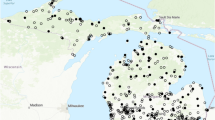Abstract
Hydrograph recession constants are required in rainfall-runoff models, baseflow augmentation studies, geohydrologic investigations and in regional low-flow studies. The recession portion of a streamflow hydrograph is shown to be either an autoregressive process or an integrated moving average process, depending upon the structure of the assumed model errors. Six different estimators of the baseflow recession constant are derived and tested using thousands of hydrograph recessions available at twenty-three sites in Massachusetts, U.S. When hydrograph recessions are treated as an autoregressive process, unconditional least squares or maximum likelihood estimators of the baseflow recession constant are shown to exhibit significant downward bias due to the short lengths of hydrograph recessions. The precision of estimated of hydrograph recession constants is shown to depend heavily upon assumptions regarding the structure of the model errors. In general, regression procedures for estimating hydrograph recession parameters are generally preferred to the time-series alternatives. An evaluation of the physical significance of estimates of the baseflow recession constant is provided by comparing regional regression models which relate low-flow statistics to three independent variables: drainage area, basin slope and the baseflow recession constant. As anticipated, approximately unbiased estimators of the baseflow recession constant provide significant information regarding the geohydrologic response of watersheds.
Similar content being viewed by others
References
AndersonM. G. and BurtT. P.: 1980, Interpretation of recession flow, J. Hydrol. 46, 89–101.
BarnesB. S.: 1939, The structure of discharge-recession curves, Trans. Am. Geophys. Union 20(4), 721–725.
BatesB. C. and DaviesP. K.: 1988, Effect of baseflow separation procedures on surface runoff models, J. Hydrol. 103, 309–322.
Bingham, R. H.: 1986, Regionalization of low-flow characteristics of Tennessee streams, U.S. Geological Survey, Water-Resources Investigations Report 85-4191.
BirtlesA. B.: 1978, Identification and separation of major base flow components from a stream hydrograph, Water Resour. Res. 14(5), 791–803.
Boussinesq, J.: 1877, Essai sur la theories des eaux courantes, Memoires Presentes par Divers Savants a l'Academic des Sciences de l'Institut National de France, Vol. 23, No. 1.
BoussinesqJ.: 1904, Recherches theoretique sur l'ecoulement des nappes d'eau infiltrees dans le sol et sur le dibit des sources. J. Math. Pure Appl. 10, 5–78, pp. 363–394.
BoxG. E. P. and JenkinsG. M.: 1976, Time Series Analysis: Forecasting and Control, Holden-Day, Oakland, California.
BrutsaertW. and NieberJ. L.: 1977, Regionalized drought flow hydrographs from a mature glaciated plateau, Water Resour. Res. 13(3), 637–643.
Demuth, S. and Hagemann, I.: 1994, Estimation of flow parameters applying hydrogeological area information, in: FRIEND: Flow Regimes from International Experimental and Network Data, IAHS Publ. No. 221, pp. 151–157.
HallF. R.: 1968, Base flow recessions — A review, Water Resour. Res. 4(5), 973–983.
JamesL. D. and ThompsonW. O.: 1970, Least squares estimation of constants in a linear recession model, Water Resour. Res. 6(4), 1062–1069.
JonesP. N. and McGilchristC. A.: 1978, Analysis of hydrological recession curves, J. Hydrol. 36, 365–374.
KelmanJ.: 1980, A stochastic model for daily streamflow, J. Hydrol. 47, 235–249.
KniselW. G.: 1963, Baseflow recession analysis for comparison of drainage basins and geology, J. Geophys. Res. 68(12), 3649–3653.
Kroll, C. N.: 1989, Estimation and usage of baseflow recession constants, M.S. Thesis, Tufts University, November, pp. 57–63.
KulandaiswamyV. C. and SeetharamanS.: 1969, A note on Barnes' method of hydrograph separation, J. Hydrol. 9, 222–229.
KunkleG. R.: 1962, The baseflow-duration curve, a technique for the study of groundwater discharge from a drainage basin, J. Geophys. Res. 67(4), 1543–1554.
PonceV. M. and LindquistD. S.: 1990, Management of baseflow augmentation: A review, Water Resour. Bull. 26(2), 259–268.
Riggs, H. C.: 1961, Regional low flow frequency analysis, U.S. Geological Survey Professional Paper 424-B, B-21-B-23, Washington, D.C.
SinghK. P.: 1968, Some factors affecting baseflow, Water Resour. Res. 4(5), 985–999.
SinghK. P. and StallJ. B.: 1971, Derivation of base flow recession curves and parameters, Water Resour. Res. 7(2), 292–303.
SpoliaS. K. and ChanderS.: 1974, Modelling of surface runoff systems by an ARMA model, J. Hydrol. 22, 317–332.
SpoliaS. K. and ChanderS.: 1979, Modelling of surface runoff systems by an ARMA model — a correction. J. Hydrol. 41, 187.
TallaksenL. M.: 1995, A review of baseflow recession analysis, J. Hydrol. 165, 349–370.
VogelR. M.: 1986, The probability plot correlation coefficient test for the normal, lognormal, and Gumbel distributional hypotheses, Water Resour. Res. 22(4), 587–590, (see correction in 23(10), (1987), 2013).
VogelR. M. and KrollC. N.: 1989, Low-flow frequency analysis using probability plot correlation coefficients, J. Water Resour. Plan. Manage. 115(3), 338–357.
VogelR. M. and KrollC. N.: 1990, Generalized low-flow frequency relationships for ungaged sites in Massachusetts, Water Resour. Bull. 26(2), 241–253.
VogelR. M. and KrollC. N.: 1992, Regional geohydrologic-geomorphic relationships for the estimation of low-flow statistics, Water Resour. Res. 28(9), 2451–2458.
WallisJ. R. and O'ConnellP. E.: 1972, Small sample estimation of ρ1, Water Resour. Res. 8(3), 707–712.
ZechariasY. B. and BrutsaertW.: 1985, Ground surface slope as a basin scale parameter, Water Resour. Res. 21(12), 1895–1902.
Author information
Authors and Affiliations
Rights and permissions
About this article
Cite this article
Vogel, R.M., Kroll, C.N. Estimation of baseflow recession constants. Water Resour Manage 10, 303–320 (1996). https://doi.org/10.1007/BF00508898
Received:
Accepted:
Issue Date:
DOI: https://doi.org/10.1007/BF00508898




